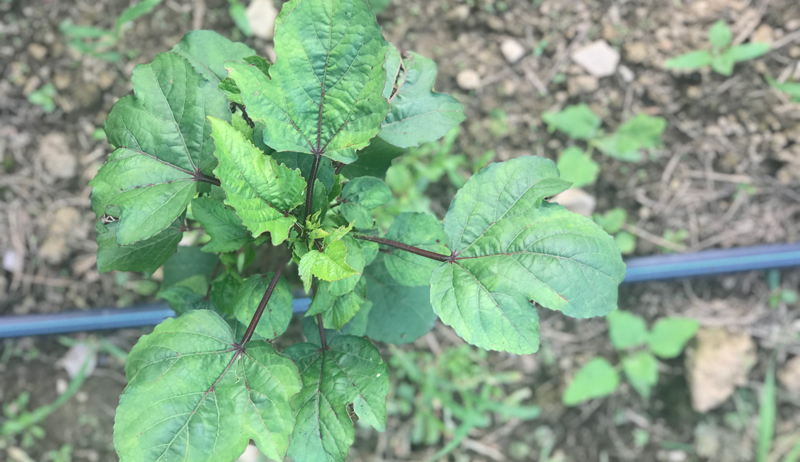
“Did you make any more of that tulsi hibiscus tea this year? My friend is crazy about it.”
My phone buzzed with that text message this morning. The sad answer is no, because my roselle hibiscus seed was old and didn’t germinate this year. (Tulsi, on the other hand, is not in short supply.)
This question reminded me of how I am also crazy about the tart, cranberry-like flavor of roselle hibiscus in tea and jelly and how much I enjoyed having the giant, beautiful plants in the garden last year. I’m now in full seed-catalog-exploring mode, just two weeks after our first frost of the season.
Read more: Grow and use these herbs to support your cardiovascular health.
How to Grow Hibiscus
In the mallow family, roselle hibiscus (Hibiscus sabdariffa) is one of 300 hibiscus varieties and has a similar growth habit to okra. You can enjoy the blooms in late summer into fall and the vibrant-green leaves with burgundy stems throughout the growing season.
In Zone 8 and north, start your seeds indoors a month or more before the first frost. Start with fresh seed—learn from my mistake—for the best germination.
Plant the roselle hibiscus plants in full sunlight as soon as possible after the soil warms. You want to give your plants the longest time to produce calyces and seeds.
Give the plants more room than you think necessary—more than the seed packet says, even. These shrubs can grow 6 to 9 feet tall and 5 or 6 feet around! Next year, I will plant a row on the edge of the garden, 4 feet apart. According to Southern Exposure Seed Exchange, the farther your plants are spaced, the better the calyx and seed yield.
Hibiscus is native to Africa and is very hardy. It loves hot and humid weather and does OK in drought as well as with too much rain, though it prefers well-drained, moist soils, as most plants do.

How to Harvest Hibiscus
The fleshy, red calyx—the whorl of tender, petal-like sepals that encloses the seed—and the seed are the parts of the plant that you’re likely after. Harvest after the flower falls away, when the calyx is tender and filled out with a seed.
Use snips to cut off the calyx at the stem, or snap it off by hand if it’s tender enough. The lowest on the plant ripen first, like tomatoes, and you can harvest a little at a time.
Depending on your growing season, you could end up with 5 to 12 pounds of calyces and seeds per plant.
If you’re harvesting leaves, these are cut and come again and will regrow about once a month.
Harvest all parts of the plant before temps dip into the 30s. Cold weather can damage the calyces, and frost will kill the plant. Hibiscus can be grown as a perennial in Zone 9 and south.
Read more: Try hibiscus to protect and improve your heart health!
How to Eat Hibiscus
Hibiscus is not so much a crop that you eat fresh, though I did read about—yet have no experience with—eating the young leaves as you would garden sorrel and more mature leaves in stir fries and stews.
One of the alternative names for roselle hibiscus is Jamaica sorrel—and if you’ve ever been to an authentic Mexican restaurant in America, you’ve probably seen jamaica iced tea. It’s refreshing, and it will make you want to grow this plant.
As far as small-scale farmers go, hibiscus is a value-added-products dream. My favorite use is to dry the calyces for tea. You might use them to flavor wine or kombucha. Bring out the sugar for making jelly—the calyces have a lot of natural pectin—or syrups.
Hibiscus calyces are good for you, with antioxidants, riboflavin, ascorbic acid, niacin, carotene, calcium and iron, according to the Southern University Agricultural Research and Extension Center. They may also have medicinal value.
I also know of folks in other countries roasting the seeds, grinding them, and using them as a high-protein coffee substitute.
I am grateful to my friend for sharing the herbs that I grew and for reminding me of the roselle hibiscus crop that I can look forward to next year. These cheery things give me a goal as I sit with the seed catalogs in the gray days of fall and winter.




